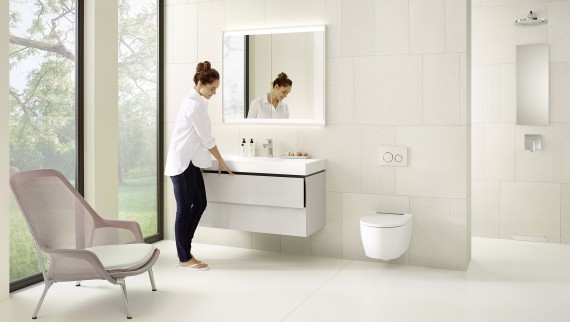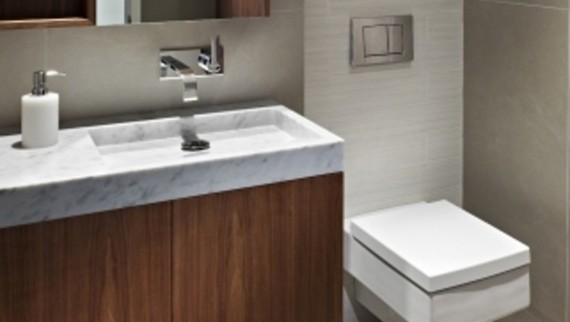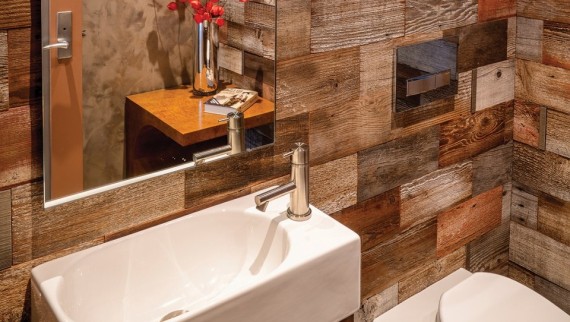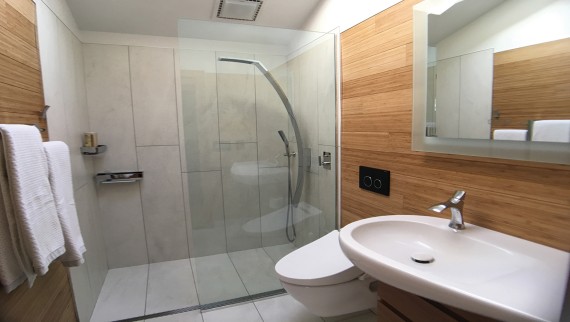Bathroom renovations: how to go about it!
Every day, we spend an average of up to one hour in the bathroom. Sanitary products are often subjected to decades of wear and tear, and bathroom furniture is exposed to high levels of moisture. That's why it's worth investing in good equipment to create a space that you can enjoy and feel comfortable in.
Here, we explain how long it takes to renovate a bathroom and what costs you should expect. In addition, we will guide you through the renovation process step by step, offering useful expert tips along the way.

How long does a bathroom renovation take?
Are you considering renovating your bathroom and want to know how long it will take? It depends on the project.
| Cosmetic renovation | Renovation with new tiling | Structural renovation |
|---|---|---|
| In a cosmetic renovation, bathroom furniture, sanitary ceramic appliancesm and faucets are replaced and the walls or ceiling are painted. But the tiles remain and no other structural work is carried out. | In addition to new bathroom furniture and ceramic appliances, tiling, dismantling, plastering, or painting work is carried out. The floor plan and structure of the bathroom, however, remain unchanged. This means that the toilet and washbasin will remain in the same place, and the bathtub will not be replaced by a shower or vice versa. | For a structural renovation of the bathroom, more work is done on the structure of the building. The wall is torn open, pipes are replaced throughout the room, and appliances are moved. This may be the case, for example, if you want to move the toilet or the washbasin area somewhere else in the room or install a shower instead of a bathtub. In a structural renovation, additional trades such as electrical and HVAC are also involved. |
| As a rule, the work for a cosmetic renovation takes 1-3 days. | In this scenario, you can plan approximately 3-5 days for the conversion. | For a structural renovation, expect 1-2 weeks of work. |
The cost to renovate may be considerable, but investing in a new bathroom is worthwhile, because it lasts on average 20 to 30 years.
A little tip: where to save costs
When renovating your bathroom, you can save money on the scope and with the choice of appliances. Replacing single pieces of bathroom furniture and ceramic appliances can make a bathroom look completely new without any major structural measures. Product selection is also a decisive cost factor: Many manufacturers also offer high-quality products in the lower price segment.
From old to new: this is what modern bathrooms look like
Are you having trouble imagining your bathroom in a new light? Be inspired by these before-and-after bathroom renovation comparisons from different projects.
The challenges ranged from very little space to a lack of daylight and roof pitch. All the projects have one thing in common: the renovations have allowed the families to enjoy their beautiful new oases of well-being in timeless designs.
Before-and-after bathroom renovations Stories from around North America
How do you go about a bathroom renovation?
The decision to renovate the bathroom has been made. But where do you start? We will guide you through the stages of a renovation project and offer helpful tips along the way.
1. Bathroom planning: a good plan saves money
If you have a clear idea of what you need and what you like in the bathroom, the planning process will be more efficient.
- Make a checklist with your bathroom requirements: How many people use the bathroom and how much storage space will you need? Will several people use the bathroom at the same time, making a second washbasin area necessary? Are there enough power outlets and are they in the right place? Look ahead a few decades, too: what will your needs be then? As nice as a bathtub is now, you might appreciate a floor-even shower with a bench much more in 20 years' time.
- Get inspiration online – home design magazines, Pinterest, Instagram and manufacturers' websites are good sources of inspiration. A mood board with printed photos, color, or material samples can also be helpful.
- Contact your trusted installation company or search for a specialist partner online. There are several platforms for finding providers in your area. It might be worth getting several cost estimates and comparing them with each other.
- The selected service provider will visit you at home to measure your existing bathroom and clarify your requirements, your ideas, and the budget in a consultation.
- Then visit one or more showrooms, either at an installation company or at a wholesaler. Let expert staff guide you through the showroom (find a showroom near you here). Upon request, you will receive an appliance list with the selected products.
- If desired, the service provider can show you a 3D visualization of your future bathroom.
- The service provider then prepares a detailed schedule. They also coordinate with the tradespeople for plumbing, heating, electricity, and tiling.
2. Demolition work: remove old furniture, tiles and the like.
At this stage, it's down to the nitty-gritty, the demolition. Old furniture and sanitary products such as washbasins and toilets are taken out and the old tiles removed. Depending on the extent of the renovation, the walls may also be torn down.
Our savings tip: ask your service provider if you can do some of the demolition work yourself to save money. With a little manual skill, some dismantling work can done independently. But everything that follows the demolition work should be left to the professionals. They have the necessary knowledge of the materials, expertise, and tools. They are also usually faster, and so cheaper.
3. Laying new pipes
During a structural renovation, pipes and lines for water, heating, ventilation, and electrical are replaced.
- If sanitary objects such as the washbasin area or toilet are being moved, the water supply connections and wastewater pipes also need to be moved.
- If you are installing a new floor-even shower, the wastewater pipes and connections must be re-laid.
- An electrician will take care of the necessary electrical lines and power connections.
This step may not only affect the bathroom – the pipes all the way down to the basement might also need to be replaced.
A little tip: more and more people are opting for the convenience of a bidet toilet, which requires power connections at the toilet. Don't forget these connections in the planning phase. That way, the toilet can be upgraded to a bidet toilet. A good service provider will raise the issue during the consultation.
4. Levelling and constructing the floor
Installing an open shower always involves a conversion. You should check in advance whether the requirements for installation are met. The construction height of the floor is important to consider, i.e. the overall construction of what is called the floor screed. In addition to the flooring, this also includes other layers such as thermal insulation and piping for underfloor heating. For walk-in showers, a specific minimum height is required for the trap. If the construction height of the floor is lower than the depth of the water seal, installation may not be possible or may require very complex and expensive conversion work.
In the shower area, the floor must also have a slope so that the water runs off. For optimal drainage, the slope should be about 2%.
As the shower is a damp area, sealing is also necessary. The degree of sealing necessary (room height or only certain areas) depends on local regulations.
5. Plastering and re-tiling the walls
In this step, the walls are plastered. The tiler will install new tiles while the painter will repaint the walls and ceiling.
A little tip: large tiles give the bathroom a spacious feel and are easier to clean because they have fewer grout joints.
6. Installing new bathroom furniture, washbasins, faucets, etc.
The sanitary company will install the toilet and fit the washbasin and bathroom furniture. Faucets, handles, and lighting are also installed in the final assembly. The electrician installs switches and sockets.
Ideas from Geberit for your bathroom renovation

The bathroom trends for 2024
Meet the new bathroom trends: smart technologies, matte colors and simple designs.
How small can your basin be?
Handrinse basins in guest WCs should take up as little space as possible, but the question remains: How small can a washbasin be to still fulfil its basic function?

The perfect installation height
Deciding on the ideal installation heights for bathroom fittings often falls by the wayside in bathroom design. Find out what to look out for.




